FOR IMMEDIATE RELEASE
January 8, 2024
Contact: [email protected]
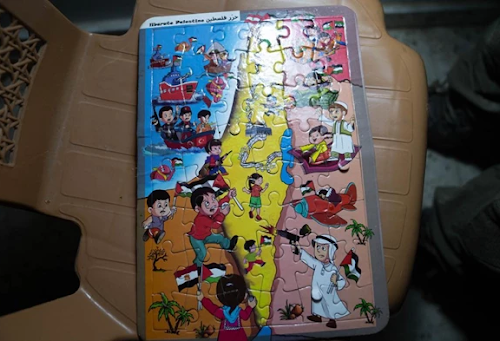
A children’s puzzle found in a Gaza home that encourages violence against Israel, January 6th, 2024
(Photo credit: Israel Defense Forces)
Since the start of the Israel-Hamas war, Israeli officials and international media have uncovered mounting evidence of Hamas’s routine indoctrination and recruitment of Palestinian children for terrorist activities. New findings suggest Hamas enforces radicalization as a core component of young Palestinians’ education, including through puzzles and games that incite violence against Israel. Hamas commanders have themselves admitted to recruiting children to carry weapons, explosives, and information to aid the war effort. Video footage released in recent weeks shows Hamas training children under 15 years of age in tunnels with mock rifles and other weapons, preparing them for armed combat.
Hamas’s long-established exploitation of minors is yet another example of the group’s war crimes and its disregard for the lives of the Palestinians they claim to represent.
Hamas has recruited Palestinian children for terrorist activities during the Israel-Hamas war, including observing IDF troop movements and transporting weapons. Yahya Sinwar, Hamas’s leader and the mastermind of the October 7th attack, reportedly employs a network of Palestinian women and children who “seem like innocent civilians but are actually passing information to him.” Israeli officials describe watching Sinwar’s child observers “stand on the roofs of houses or under the cover of buildings without weapons, only with a walkie-talkie or a telephone” to pass information to Hamas commanders.
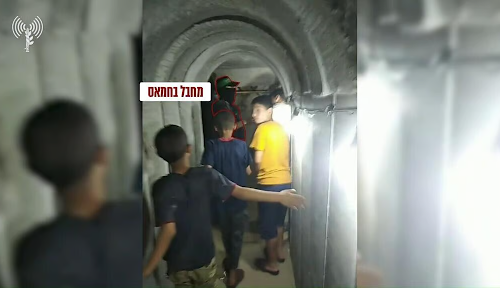
Palestinian children tour a mock Hamas tunnel.
(Photo credit: Israel Defense Forces)
Last week, Israeli officials released evidence of Hamas’s recruiting of Palestinian children for terrorist activities, sharing footage and photos of “children under the age of 15” in mock tunnels and playing with mock tanks and rifles. This evidence comes shortly after a Hamas commander admitted that Hamas uses children to conduct terrorism, including transporting explosives and conducting surveillance. Israeli forces in Gaza also report that Hamas has used fake babies, with the sounds of crying amplified over loudspeakers, to lure them into deadly traps.
From children’s games to school curricula, Hamas aims to radicalize the next generation and incite violence against Israel. A puzzle found this week in a Khan Younis home, which doubled as a Hamas stronghold, offers an example of Hamas’s radicalization tactics. It features cartoon illustrations of armed terrorists attacking Israel from land, air, and sea. According to observers, the puzzle was found in a children’s bedroom next to dolls and games, which also hid Hamas “grenades, weapons, and body armor.”
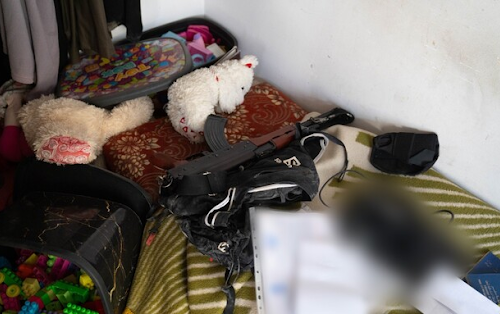
Weapons hidden among dolls in a Gaza house that doubled as a Hamas stronghold.
(Photo credit: Israel Defense Forces)
Hamas’s radicalization of young Palestinians also extends to the school system. A 2013 New York Times analysis of Hamas’s textbooks found that Palestinian students were taught a “culture of hatred” that denied the existence of Israel and omitted information about peace initiatives like the Oslo Peace Accords.
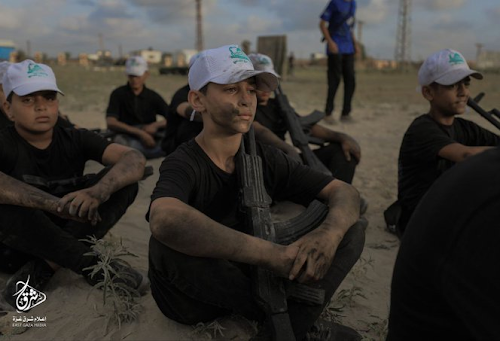
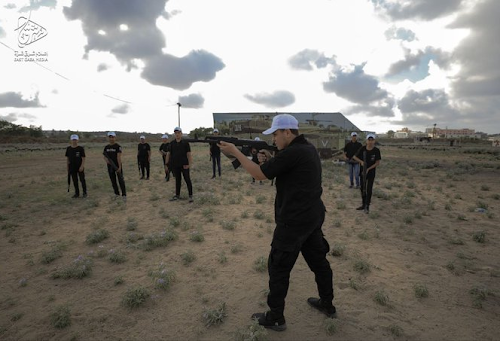
Young Palestinians train with mock rifles at a Hamas-run camp. (Photo credit: Joe Truzman, FDD’s Long War Journal)
Hamas has a long history of employing children as combatants. Hamas began recruiting and training child soldiers long before the October 7th attack. Most notably, the terrorist group has registered more than 50,000 children to an annual child-soldier training camp which has been operating for five years, according to regional reports. The children are subjected to religious indoctrination and “security training,” according to a video recorded by members of Hamas. The Hamas militants know these children are likely to die, stating they must be ready to make “sacrifices.” International human rights groups like United Nations Watch have criticized these camps as a violation of international law.
Hamas’s recruitment of child soldiers is a clear violation of international law.
According to the International Criminal Court, conscripting or enlisting children into armed forces or groups constitutes a war crime in both international and non-international armed conflicts. The use of child soldiers is also banned under the UN Convention on the Rights of the Child (CRC) and other international treaties. UNICEF has found that child soldiers often experience exploitation, abuse, psychological harm, poor nutrition and living conditions, substance abuse, and are forced to engage in hazardous labor with high risks of death, injury, and disability. Girls are often subjected to gender-based violence.
###